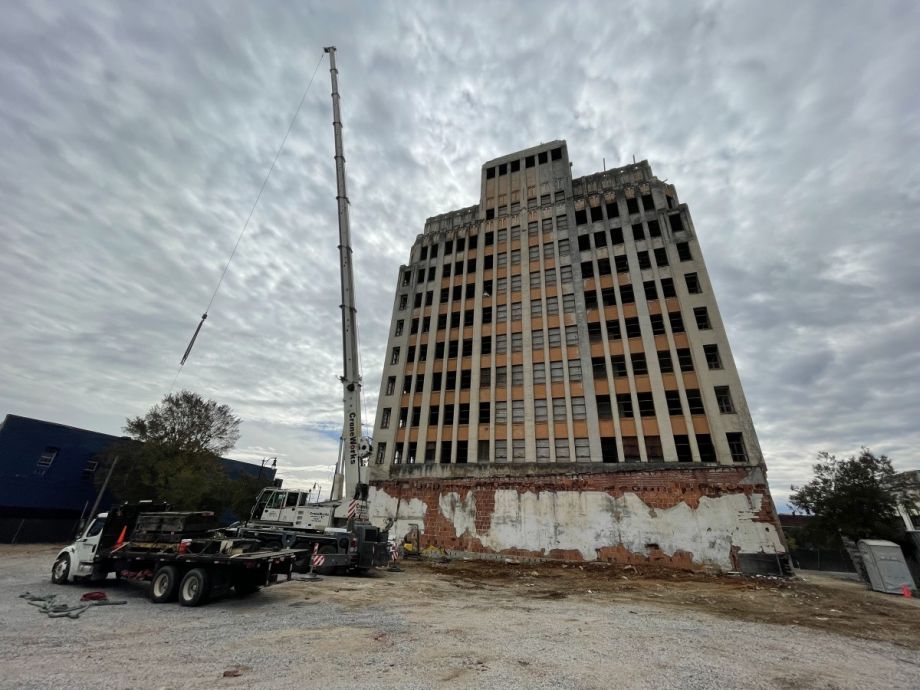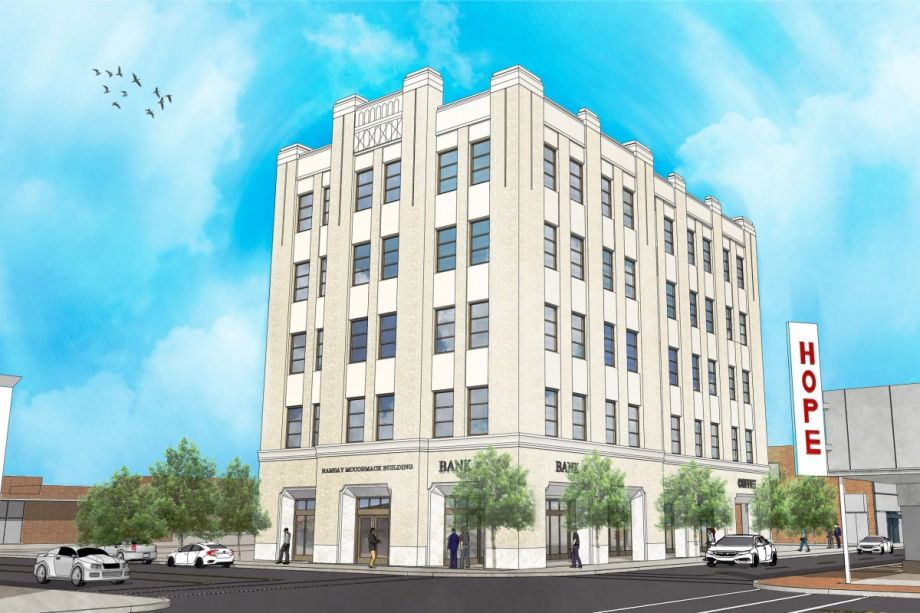Randall Woodfin wore a hole through his leather loafers going door-to-door campaigning for Birmingham’s mayoral race in 2017, ultimately beating a two-term incumbent to become the city’s youngest mayor in more than 120 years and one of its most progressive of all time.
He particularly remembers introducing himself to residents of Ensley, a historically segregated neighborhood that suffered from the decline of the city’s steel industry. “They wanted better,” Woodfin recalls, “And after listening to residents I knew they deserved better.”
Soon into Woodfin’s mayoral term, his administration turned its focus on Ensley’s historic business district — the former heart of the neighborhood that the city has ignored for decades. In early 2019, city officials called for proposals for redevelopment of its buildings and properties. By October of 2020, Woodfin’s administration launched redevelopment of a well-known Ensley landmark, the long-dilapidated Ramsay-McCormack Building, into a community-centered startup hub.
 “We don’t look at this as a city building, we look at it as a community building,” Woodfin says of the investment.
“We don’t look at this as a city building, we look at it as a community building,” Woodfin says of the investment.
The 1928 10-story office building has loomed large since the Woodfin administration began exploring ways to revitalize the district. As the tallest building in the neighborhood, it’s clearly visible from the nearby highway. Despite its prominence, the building has been vacant and crumbling since the city acquired it in 1983.
“The primary concern from the community was for the building to be demolished and have something else there,” explains Coreata Houser, deputy director of the city’s Department of Innovation and Economic Opportunity. “It sounds very generic, but for over 40 years the community has watched the building sit and become an eyesore.”
The city decided to invest in the building with support of local business owners and community leaders like Ensley’s Neighborhood Association president. The goal was to bring in an industry that spurred more foot traffic across the district. “That kind of foot traffic expands to entertainment, like bars, breweries, restaurants, whatever,” Woodfin says. The vision for the community redevelopment plan became the creation of an “innovation hub,” surrounded by an entertainment district.
“With this building, because we own it, we believe we can drive foot traffic to this area by first supporting an innovation hub which allows start ups and entrepreneurs who want to take risks but need city help and support, which we can provide,” says Woodfin.
Before construction began, the city secured two anchor tenants eager to root themselves in Ensley. The first is The Birmingham Promise, which offers college scholarships for Birmingham City Schools students as well as apprenticeship opportunities at companies across the city. It will run its headquarters from Ramsay-McCormack.
The second is Innovation Depot, currently located in downtown Birmingham providing office, lab, and coworking space for startups and entrepreneurs. The Ensley location will mark the company’s first expansion. “We see this as widening the funnel for opportunity and being able to touch a lot more lives, making people aware who might not have been if their life doesn’t center around downtown,” says Brit Blalock, director of marketing for the company.

The Ramsay-McCormack building has sat empty for 40 years. (Photo courtesy City of Birmingham)
Voltage, a brand new program, will provide support to entrepreneurs with tech-enabled business ideas. The program is currently offered at Innovation Depot downtown and will be expanded to the Ensley location. “We think it will be a fantastic program for Ensley because you just have to come to the program with an idea for the business and be ready to devote some of your outside-of-work life to explore if it’s a viable idea,” Blalock explains.
The building is set to open in 2022. Work is already underway to deconstruct the original structure. Materials salvaged will be used in a new five story, 30,000 square foot building designed to reflect Ramsay-McCormack’s original architecture. Like the original building, the new construction will be the tallest building in the neighborhood.
Woodfin and his team are trying to integrate racial equity into as many components of the project as possible. The city worked with minority and women-owned business firms in the pre-development process and will solicit proposals from minority and women-owned firms for construction, development and operation of the building.
This past fall, Woodfin joined the inaugural Just City Mayoral Fellowship, a collaboration between the Mayors’ Institute on City Design and the Just City Lab at the Harvard Graduate School of Design. The fellowship asked each mayor to select a predominantly Black neighborhood in their city that’s historically seen under-investment, so they could receive feedback on planning and design interventions that center racial justice.
Woodfin picked Ensley and has focused on the Ramsay-McCormack revitalization throughout his fellowship. “When you look at this area, it’s 100 percent Black residents who have not had the resources they need to be successful,” he says. “Through a racial equity lens, we wanted to focus on place —what currently exists here and shouldn’t be there — and find a way to remove it.”
The first step, he believes, is removing a blighted neighborhood landmark and replacing it with something new. There’s still plenty of work ahead, from building local trust and keeping the community engaged, as well as securing more tenants responsive to the neighborhood’s needs. After the building opens, the administration will still face the larger challenge of revitalizing the district. “It feels more real that we can turn Ensley around,” as Houser put it, “But it’s a huge, huge undertaking given the disinvestment over 40 years.”
With Woodfin facing reelection this August, he’s come full circle from his early campaigning in the neighborhood. “One of my core values is accountability … it’s keeping my passion alive about this area and my commitment to it, and the sense of urgency that we follow through on what we said we wanted to do here.”
This article is a part of “Design Leaders,” a series highlighting mayors’ roles in design and the built environment in their cities. Design Leaders is made possible with the support of The Mayors’ Institute on City Design, a National Endowment for the Arts leadership initiative in partnership with the United States Conference of Mayors.

Emily Nonko is a social justice and solutions-oriented reporter based in Brooklyn, New York. She covers a range of topics for Next City, including arts and culture, housing, movement building and transit.
Follow Emily .(JavaScript must be enabled to view this email address)
















